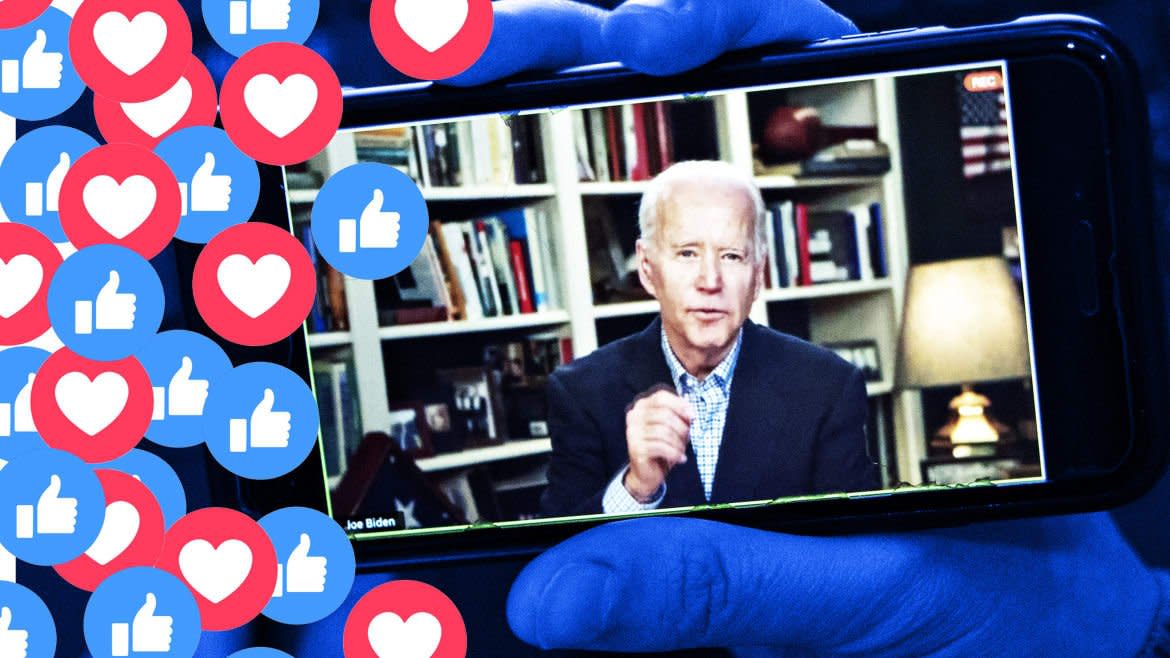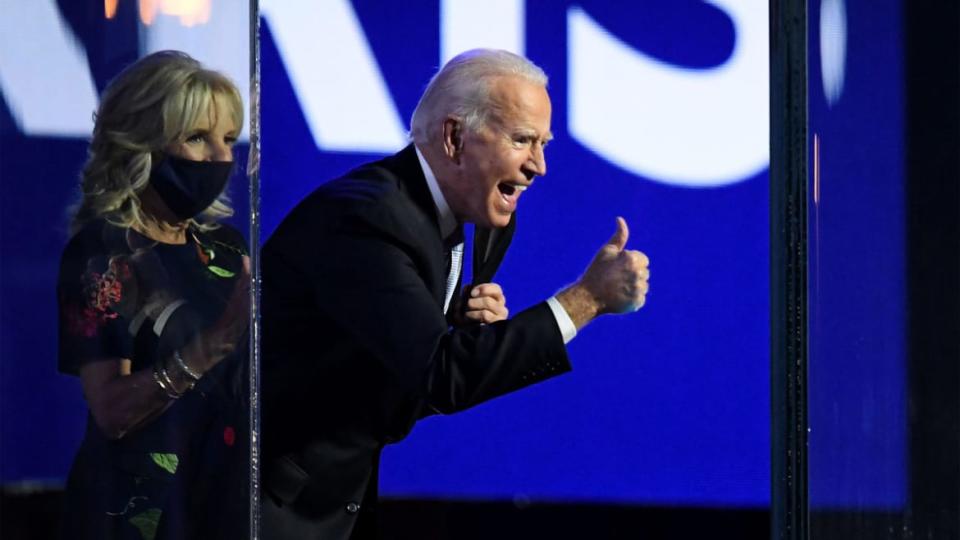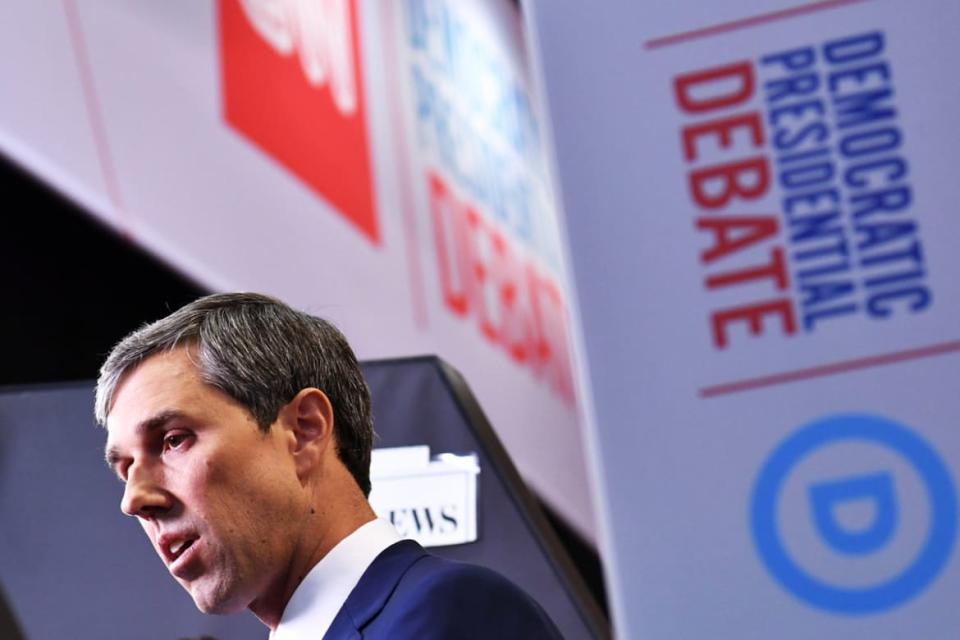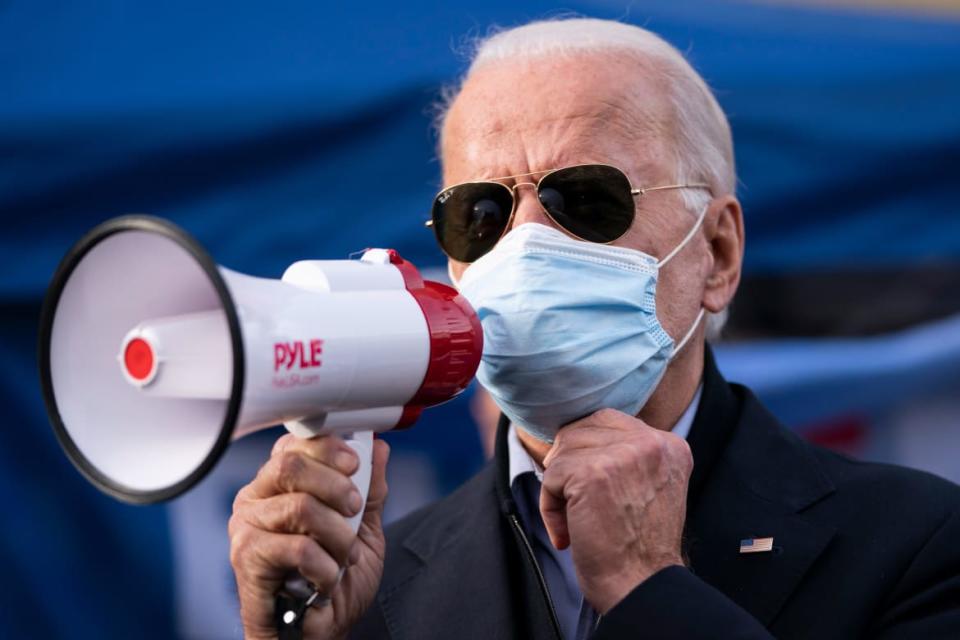Biden Won the Battle—but Dems Are Losing the Social Media War

- Oops!Something went wrong.Please try again later.
- Oops!Something went wrong.Please try again later.
As the 2020 election hit its homestretch, Joe Biden’s digital team began seeing alarming trends online.
Posts about the candidate’s son Hunter Biden and the contents of his laptops were spreading at incredible rates. Many of the posts were misleading, at best. Biden’s campaign had set up a comprehensive monitoring system to track the proliferation of disinformation across various platforms. And they’d seen their fair share of rumor, innuendo, and smear fly across the internet before. But this was entirely different in its scope. According to their data, there was more social chatter happening around the Hunter Biden story than there had been around stories about Hillary Clinton’s emails during the last month of the 2016 campaign.
Fearing a redux of that disastrous end-of-the-campaign implosion, the team dove further into the research. What they found there was more assuring. While the Hunter Biden story had taken off on Facebook, YouTube, and various right-wing sites, it had not crossed over into mainstream outlets. The campaign’s internal polling, meanwhile, showed that voters largely weren’t persuaded by it.
The wildfire ended up being mostly smoke. But even so, it provided the Biden campaign with yet another reminder about the perils that social media platforms present to Democrats as they traverse the modern political landscape.
As the party takes stock of an election in which it suffered unexpected losses down-ballot and a major triumph at the top of the ticket, at least one area of agreement has emerged: Democrats are still losing the war online. Part of the deficit is strictly a matter of cash. Last week, Rep. Alexandria Ocasio-Cortez (D-NY) publicly chastised her fellow Democrats for not making more robust investments in digital advertising. But much of it, those in the field say, is in building the type of news and organic content ecosystem that can match the scale that currently exists on the right.
“The issue is that when you look at campaign engagement, most of the ad spending is not about persuasion, it is about donor and supporter acquisition,” said Ari Rabin-Havt, Sen. Bernie Sanders’ (I-VT) top campaign aide and a longtime operative at the intersection of traditional and digital politics. “That’s only one part of what campaigns need to do to succeed.”
At the Democratic National Committee headquarters and within the Biden campaign, the power of conservative pundits and media entities online was no secret. The major social media platforms prioritized engagement over all else, which meant that outrage and conspiracies—both currencies of the Trumpier parts of the Republican Party—were often the most trafficked content. At Facebook, moreover, it was widely believed that company leadership went out of its way not to anger conservatives for fear of being accused of bias (it would turn out, in fact, that Facebook actively throttled traffic to left-wing sites).

Jill and Joe Biden.
Aides tasked with monitoring this universe compared it to a “centipede” where disinformation started as a kernel in one spot and maneuvered its way through a chain of larger and larger pages and platforms. Salem Media, Western Journal, Judicial Watch, The Bongino Report, InfoWars, Ben Shapiro, and Daily Wire would all pass along similar stories, videos, and recordings, providing a type of information feedback loop that was boosted by Facebook’s algorithm and—more importantly—drew in audiences who never felt like they needed to go elsewhere for news.
“Fox News,” said one Biden campaign staffer, “became the left pole of the media ecosystem for a lot of people on the right. There is a broad swath of the American right for which Fox News is now the center, and the info they rely on is from their friends online and on Facebook.”
On occasion, that loop would spill out over into more mainstream outlets, forcing the Biden campaign to react. One trouble spot it found early on were memes and videos made to portray Biden as senile. But research showed that the campaign was able to beat back against those impressions by simply pushing out videos of Biden in a natural setting.
Another more humorous incident came before the first debate, when a swath of the online right began theorizing that Biden would sneak in an earpiece.
“We assumed people were not persuaded by it,” the Biden aide recalled. “But it became such a part of the conversation that we felt we needed to respond.”
The result was a Biden tweet mocking the chatter. What had seemed like a spur-of-the-moment attempt at poking fun at the conspiracists was, in reality, a calculated decision to take steam out of viral content from the right.
It’s debate night, so I’ve got my earpiece and performance enhancers ready. pic.twitter.com/EhOiWdjh1b
— Joe Biden (@JoeBiden) September 29, 2020
For President Donald Trump, the feedback loop was an important tool at his disposal. Daily rankings of the top performing Facebook posts always featured Trump-supportive sites while YouTube became a breeding ground for conspiracy theorists. An entire insular world was metastasizing that wasn’t being picked up in the polls or influenced by the media.
Even the QAnon conspiracy had its tactical benefits. Biden campaign tracking data showed the community—which holds that major U.S. institutions are actually being run by a cabal of Satan-worshiping pedophiles—growing beyond “the fringe” as the country was locked down during the COVID-19 quarantine in the spring. Soon enough, its adherents began spreading wild lies about Biden (such as him owning a private island near Jeffrey Epstein’s) in addition to their usual threads on Hollywood celebrities and the Clintons.
On top of that, moments that should have been politically damaging for the president were turned into powerful tools to buck up his supporters and reinforce his key messaging.
“Impeachment was so bad for us because it fit into [Trump’s] meta-narrative that they reinforced every day,” said Tara McGowan, a leading Democratic digital strategist, referring to the persistent “deep state” conspiracy theories and allegations of Biden family corruption that pervaded conservative media amid the historic rebuke of the president.
Months later, as racial unrest erupted—occasionally violently—in cities around the country, Democrats faced the same feedback loop of conservative posts and commentary that reinforced some of the president’s central political messaging. The riots in Kenosha, Wisconsin, following the shooting of a Black man by police there created such a scare for the Biden digital team that it was one of the few times they advised the communications shop to forcefully push back against the emerging narrative (in this case, of Biden being on the side of the protesters).
“I don’t know that we would’ve been able to recover from the law-and-order narrative if the president himself hadn’t contracted the virus,” said McGowan, describing the president’s coronavirus diagnosis as a seminal moment that shifted the online conversation back to his poor handling of the pandemic. “Frankly, if the pandemic had not come,” she said, “I think we would’ve absolutely lost this presidential election.”
McGowan has more insights into the precariousness of the Democratic Party’s position in the online wars than most.
When Democrats emerged from the wreckage of the 2016 election, she and others vowed that they would dramatically scale up their digital footprint to match what Trump had brought to bear. And, to a degree, they did. Biden’s campaign managed to keep pace with Trump’s behemoth online advertising operation this year, in particular its focus on Facebook ads, a lynchpin of Team Trump’s heralded online infrastructure.
But McGowan and other Democrats steeped in the world of digital politicking say the party ended up spending all its time fighting the last war rather than anticipating the next one. Determined to put up raw numbers that rivaled past Republican dominance on platforms like Facebook and YouTube, they failed to grasp what makes for a truly effective digital strategy. It’s not about flooding the zone with paid content, these Democrats say. It’s about building lasting infrastructure that speaks the language of the tens of millions of voters—and growing—who grew up on these platforms and navigate the digital world in ways that can’t be mapped or exploited by decades old political advertising strategies.
One Democratic strategist who spoke with The Daily Beast pointed to two recent efforts, Pulso and PushBlack, as examples to emulate—social media-centric subscription news services that cater to discrete constituencies and which, toward the end of the cycle, shifted their attention to voter registration and get-out-the-vote efforts.
“They’re still applying a traditional, poll-tested message deployed in a broadcast manner across channels to traditionally modeled universes of voters,” McGowan said of party leaders. “Even though they’re spending more to reach these voters online, they’re not rethinking who these people are, what messages really resonate with them.”
“It’s not enough to just pour more money into one-way ads if we’re not actually building audiences or infrastructure,” she added.
But the party is divided about how much to prioritize the digital space. There are factions, which include McGowan, that have invested in creating a constellation of online advertisers and content hubs, including a controversial network of localized quasi-news outlets. There are others, however, who think the onus right now has to be on counteracting and limiting the reach of the false and misleading information spreading on social media networks.
“We don’t care about having the one viral video that everyone saw but didn’t actually achieve our goals,” said Becca Rinkevich, director of political programs at the digital firm Bully Pulpit. “We care about showing a united force and having these other credible voices weigh in. It’s a lot more work to do that sort of disciplined message.”
Biden ultimately was able to maneuver through the social media minefield. But other Democrats were not as fortunate. In a memo detailing his explanations for why the party failed to perform better in Texas—after so much hype that they would—former 2020 presidential candidate and former Rep. Beto O’Rourke placed one issue above all others.
Among Republicans’ “asymmetrical advantages” that Democrats need to counter, O’Rourke wrote, is “the ability to campaign free of the truth,” a tactic that he attributed largely to “social media and texting campaigns” undertaken by the president’s campaign and supporters.

Beto O’Rourke.
“We have to be more effective on digital and social media,” O’Rourke wrote. “The anecdotal takeaway from those I’ve listened to, especially in border communities, is that Trump/GOP had a ferocious game” online, he said, “and we had none.”
Not everyone in the party buys the logic. There is a thread of thinking among some Democrats that the insular universe that conservatives have built online is both impenetrable and not worth duplicating.
“The way that they’ve constructed what gets play on their platform is just a petri dish of misinformation and extremism,” said Maddie Kriger, who serves as integrated media director at Priorities USA, about Facebook’s algorithm. “My personal view is that there is no way for someone who is not basically telling lies to game the system.”
But others who work in digital politics argue that the party can’t simply assume that its voters will always be reachable through traditional means; and that it is a massively important investment to create online content that can bring in new audiences. The question isn’t whether to do it, they say, it’s how.
David Goldstein, the CEO of the digital media organization Tovo Labs and a former Obama pollster, estimated that he was on “at least one to two hundred different conference calls” with Democrats this cycle and heard only one person mention talking to Trump voters on Facebook.
“If you were to say to the Democrats, ‘OK, there’s this evangelical group that are 80 percent against you,’ the immediate Democratic response is ‘Whoa, we’ll never catch them,’” he said. “Tell a Republican group that ‘Hey, this group of urban Black women are 94 percent against you,’ [and] they immediately think, ‘Oh! This 6 percent is for us.’”
While there are entities on the left that specialize in online content creation—such as The Other 98% and Occupy Democrats—their reach is limited compared not just to those on the right but to the Sanders-minded outlets whose content is most anti-establishment in nature.
Operatives say this is, in part, due to a fundamental difference in how the parties currently operate. While the Trump era has birthed a type of political-media-celebrity hybrid who can draw major audiences online (think: Dan Bongino), Democrats fell behind someone, in Biden, whose candidacy was built around the notion that understatement was good.

Biden in Philadelphia on Nov. 3.
“The right is able to cultivate these personalities on Fox News. Sit down and watch Hannity over the week, it’s the same 10 people over and over,” said one Democratic communications strategist. “They build up a celebrity on the right in a way that we just don’t do on the left. Those celebrities then take their content to Facebook, and then they all interact with each other and push their content out.”
But a good chunk of it is structural too. Democratic digital operatives say the party has simply transposed its traditional broadcast advertising strategy onto digital media platforms rather than attempting to build up a permanent online infrastructure native to digital platforms themselves. More than one digital strategist noted with varying degrees of scorn that the Center for American Progress—the party’s preeminent think tank—decided to shut down its online publication Think Progress rather than turn it into a content creation farm for Facebook and YouTube.
“The party needs to dedicate far more resources toward long-term and online organizing as opposed to paid advertising or specific candidate support,” one Democratic digital strategist told The Daily Beast.
This cycle, support for that sort of program was difficult to come by. McGowan says she was forced to turn to investors in Silicon Valley, who grasped the nuances of her vision for online politicking far better than traditional hubs of Democratic financial support, to fund her network of political and advocacy groups. Those running the commanding heights of Democratic politics, she said, are simply too entrenched—and financially invested in—traditional modes of politicking to hope for much support in the upper echelons of the party’s political apparatus.
“Whether you’re talking about the donors or the leaders of the party or the largest super PACs, they all have been working together for many, many years, and this is the playbook they know. And people are very averse to embracing and advocating and deploying a playbook that is not native to them,” McGowan said. “We need anyone who is not native on the platforms where the majority of Americans spend their time to not be in positions of leadership that determine budgets.”
“The people who stuck around after 2016 because they wanted to go out on a high note, we need them to now go out on a high note,” she added, “and we need people who understand where the information war is being waged in positions of power and authority.”
—with reporting by Jackie Kucinich
Got a tip? Send it to The Daily Beast here
Get our top stories in your inbox every day. Sign up now!
Daily Beast Membership: Beast Inside goes deeper on the stories that matter to you. Learn more.

